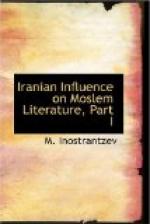[Footnote 1: We refer mainly to the epic cycle of Soistan for the views of the authorities on which see Mohl (LXII) and Noeldeke National Epic, 80-81. As a supplement to the bibliography furnished by Noeldeke see V. Rugarli, the Epic of Kershasp, G.S.A.I., XI, 33-81, 1898.]
[Footnote 2: LXVII, note 2.]
[Footnote 3: On the process of the latter nature see Mohl LXXII ff. Regarding one of the principal representatives of the later stage of this development see Abu Taher Tarsusi, Encyclopaedia of Islam, 1, 115.]
[Footnote 4: Fihrist 120, 1-13. For this kind of poetry see Fihrist 306, 8-308, 14, and compare also the books characterised at page 314, 1-7.]
To the same type of literary monuments we have to add the vast field of story literature. Although a considerable portion of it belongs to the province of migratory subjects, and although to Persia belongs often only the role of the transmitter, nevertheless, collections of stories of this class undoubtedly had their assigned place in the Sasanian epoch and the dependence of the core of the Thousand and One Nights on the Persian stories collected in the Hazar Afsan[1] is indisputable. We shall not, therefore, stop here further regarding facts which have been decided more than once. We will only observe that in connection with the Persian literary age of the Sasanians we have to indicate a series of works of the character of epic tales arisen from the ancient historical period of the western boundary of Persia and representing “stories of the Babylonian kingdom” which have been enumerated among the books of this class and also among Persian books,—a circumstance which proves that these tales originated in Sasanian literature. Finally, just as in historical and especially in narrative literature, Persian tradition survived to the Musalman times so also it continued to live in the writings of the ethico-didactical category. The importance of the Pahlavi translation of the book of Kalileh and Dimneh for the migration of this collection of tales to the West is well-known. The significance of Pahlavi translations is not less evident with regard to the Hazar Afsan in connection with the Thousand and One Nights. Still Persian tradition in the field of ethico-didactic literature has been studied and appreciated much less than in the historical and story literature. We have now to examine a few questions in connection with the Persian tradition regarding the ethico-didactic literature of the early Musalman epoch. We shall devote the following chapter to its study.




